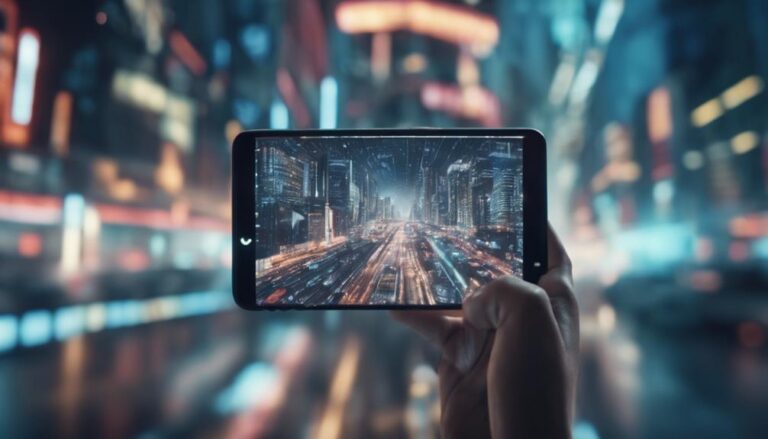I've noticed that machine learning dramatically enhances programmatic advertising. First, it optimizes ad placements by predicting user behavior, ensuring ads appear where they'll perform best. Second, machine learning refines audience segmentation for precision targeting, delivering ads to the right users. Third, dynamic bidding algorithms adjust bid amounts in real-time, optimizing ad spend. Fourth, it drives enhanced personalization, crafting ad content that resonates with specific audiences. Lastly, real-time analytics provide immediate insights, allowing for swift adjustments and improved campaign success. By focusing on these areas, you can leverage machine learning for superior advertising outcomes. Let's explore this further.
Key Takeaways
- Machine learning optimizes ad placement by analyzing user behavior and engagement patterns.
- Precision targeting ensures ads reach the right audience by predicting user interests and behaviors.
- Dynamic bidding adjusts bid amounts in real-time to maximize ad spend efficiency and conversion rates.
- Enhanced personalization tailors ad content to specific audience segments, boosting engagement and ROI.
- Real-time analytics provide immediate insights, allowing for swift data-driven adjustments to ad campaigns.
Optimized Ad Placement
Machine learning algorithms analyze vast amounts of user data to optimize ad placements on websites and apps, guaranteeing ads reach the most receptive audiences. By leveraging user behavior and engagement patterns, Machine Learning in Programmatic predicts the most effective ad placements.
Automated ML tools work in real-time, continuously adjusting ads to match the right audience at the right moment. This methodical approach enhances targeting precision by identifying relevant ad placements tailored to each user's preferences. Consequently, ad performance improves as these algorithms adapt to changing trends and user preferences.
Precision Targeting
Building on the optimized ad placements, precise targeting leverages machine learning to analyze user data, such as demographics and behaviors, for delivering highly relevant ads to specific audience segments.
By employing advanced ML algorithms, I can optimize audience segmentation, guaranteeing that each ad reaches the most appropriate users. These algorithms predict user behavior and interests in real time, refining targeting strategies with each interaction.
Dynamic Bidding

In the ever-evolving landscape of programmatic advertising, dynamic bidding leverages real-time data to optimize bid amounts based on user behavior, ensuring that ad spend is maximized efficiently. Machine learning algorithms analyze historical data and user interactions to predict conversions, adjusting bids in real-time. This allows for ideal ad placements and helps advertisers stay competitive in auctions. By incorporating dynamic bidding, we can achieve superior ad spend optimization, ensuring that every dollar works harder. Here's a snapshot of how dynamic bidding enhances programmatic advertising:
| Aspect | Benefit |
|---|---|
| Machine Learning | Real-time Bid Adjustments |
| User Behavior | Enhanced Ad Placements |
| Conversions Prediction | Increased ROI |
| Ad Spend Optimization | Cost-effective Bidding |
| Competitive Auctions | Improved Market Position |
Dynamic bidding is a game-changer in maximizing the impact of our advertising strategies.
Enhanced Personalization
Leveraging machine learning, we can create highly personalized ad content tailored to individual user preferences and behaviors, greatly enhancing engagement and conversion rates. By utilizing ML algorithms, we analyze vast datasets to craft ad campaigns that resonate with specific audience segments.
This level of customized advertising guarantees that each user receives relevant ad content at the best time and on the right platform. Enhanced personalization through ML doesn't just capture attention—it drives action, greatly boosting conversion rates.
Programmatic advertising powered by ML leads to higher ROI, as ads are more likely to convert due to their tailored relevance. This advanced personalization is a game-changer in delivering impactful, user-centric advertising experiences.
Real-Time Analytics

Real-time analytics, powered by machine learning, provide advertisers with immediate insights into ad performance, allowing for swift and informed campaign adjustments. Machine learning algorithms analyze ad performance data in real-time, enabling us to optimize ad placements for better ad engagement.
By processing vast amounts of data instantly, these algorithms guarantee our targeted ads reach the right audience. This real-time data analysis also allows us to adjust bidding strategies on the fly, enhancing programmatic advertising efficiency.
The instant insights gained from real-time analytics empower us to make quick, data-driven decisions, improving overall campaign success. Fundamentally, machine learning transforms vast data into actionable intelligence, driving more effective and efficient ad campaigns.
Frequently Asked Questions
What Are the Benefits of AI in Programmatic Advertising?
AI in programmatic advertising boosts audience segmentation and predictive analytics, improves real-time bidding and ad placement, enhances click-through and conversion rates, guarantees cost efficiency, strengthens fraud detection, and refines personalization strategies through advanced data analysis.
Is Programmatic Advertising Machine Learning?
Yes, programmatic advertising leverages machine learning for data segmentation, audience targeting, and predictive analytics. It enables real-time bidding, behavioral analysis, dynamic creatives, automated optimization, algorithmic buying, contextual relevance, and conversion tracking, ensuring innovative ad efficiency.
How Do I Optimize Programmatic Ads?
To optimize programmatic ads, I segment data, track conversions, target audiences precisely, and place ads strategically. I allocate budgets wisely, monitor click-through rates, bid in real-time, create compelling ad creatives, detect fraud, and control ad frequency.
How Is Machine Learning Used in Advertising?
Machine learning in advertising enhances audience segmentation, creative optimization, and click prediction. It improves bid optimization, ad personalization, and real-time bidding. Additionally, it aids in fraud detection, contextual targeting, conversion tracking, and detailed data analysis for better results.
Conclusion
With machine learning, programmatic advertising transforms into a symphony of precision and efficiency.
I've seen optimized ad placement seamlessly match ads to ideal contexts, while precision targeting zeroes in on the perfect audience.
Dynamic bidding acts like a well-tuned engine, responding to market changes in real-time.
Enhanced personalization creates tailored experiences, and real-time analytics illuminate the path forward.
Each component harmonizes, creating a masterpiece of modern advertising.
The future is bright, dynamic, and meticulously optimized.






